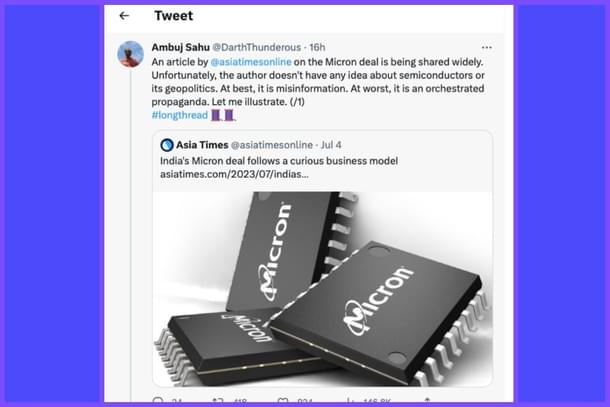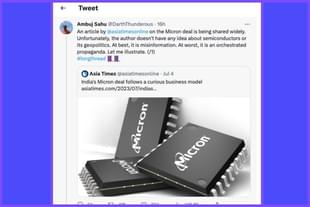Tech
Chip Wars: Propaganda Against Indian Government's Micron Deal Gets Called Out On Twitter; Here's A Summary
Swarajya Staff
Jul 09, 2023, 06:13 PM | Updated 06:11 PM IST
Save & read from anywhere!
Bookmark stories for easy access on any device or the Swarajya app.


Recently, the Indian government in a decisive move has given the green signal to Micron, a US-based chip maker, to establish a semiconductor test and packaging unit in the country.
This project is estimated to be worth USD 2.7 billion and has been heralded by many experts as a major breakthrough for India's chip-making industry. With the approval of this project, it is anticipated that around 5,000 job opportunities will be created.
Despite the gains that India is expected to garner from this decision, there has been concentrated efforts from some quarters to discredit this deal.
One such example is a recent article in Hong Kong-based Asia Times. The article which has been written by one Prabir Purkayastha, founding editor of Newsclick.in, has been criticised by several experts.
Ambuj Sahu, a doctoral scholar at Indiana University, alumnus of IIT Delhi and founder of Indian Foreign Policy Metrics has contested, deconstructed and rebutted the entire article, point by point, in a Twitter thread which has been expanded and explained below.
To repeat, what follows is a curation of the Twitter thread by Sahu. The original thread can be read here.
The Asia Times article begins by arguing that India has "completely missed the bus on key technologies" involved in chip making and that packaging of the chips, their assembly and testing is "a relatively low end of the electronics industry."
Painting the entire process with a broad stroke of being relatively low-end deliberately conveys a misleading image of it as some kind of primitive convey chain work whereas in actuality it requires a high amount of skills and technological knowledge.
The next point made in the article is that the Micron deal doesn't concern itself with the "core technologies of designing and fabrication of chips, let alone the holy grail: the lithographic machines that are central to chip fabrication."
To put it in context, there are two models of semiconductor production - IDM and Fabless. The fabless model is more prevalent in the industry, with countries/companies developing specialised in particular components in the supply chain.
While Lithography is definitely critical, it provides only one of many equipment needed to build chips.
What the Asia Times article recommends in effect, according to Sahu, is that India should first concern itself exclusively with manufacturing chip-making tools before it can make chips. which is much similar to what Jawaharlal Nehru sought to do in 1950s with heavy industries which many eminent economists now believe was disastrous and led to meagre pace of growth.
India has to choose between many stages of the supply chain. According to a report, if a country wants to own the entire supply chain, it needs approximately 3 trillion dollars which would be virtually amount to selling the entire country only to develop an industry.
Another insinuation made in the Asia Times article was regarding Foxconn-Vedanta fabrication proposal where it has been alleged that Foxconn "does not have any experience in chip making."
In reality, Foxconn is the largest tech manufacturer and service provider and follows IDM model that is making chips end to end. In India, it is setting up a fabrication system with Vedanta for mature nodes and an optical display facility.
Foxconn manufactures electronic products for many major American, Chinese, Japanese, Finish and Canadian companies.
And the significance of semiconductor chips doesn't rest with manufacturing alone, What are its applications? How should the chips be optimally utilised? Foxconn has the expertise to answer all these questions.
Another major woe expressed in the Asia Times piece was that "India is not competing with the United States, China, South Korea and Japan on chip making but with countries like Malaysia".
First, the condescending attitude towards Malaysia could be avoided.
Secondly, the answer to this charge lies in understanding the geopolitics of chips. It is well known that China is an openly hostile nation with expansionist designs. And most southeastern Asian ports open in the South China Sea which is a conflict-prone region.
In such a situation, as Assembly, Testing, Packaging of chips is a labour-heavy industry, India can easily emerge as a suitable location for it. It will secure supply chains not only for us but for the world.
Is it not a good geopolitical leverage to worth to have?
The third point highlighted in the article concerns the scale of subsidies offered by Indian government.
This argument again only serves to showcase the authors' ignorance about the history of semiconductors.
The US started by having military contractors buy American chips at twice the price to boost up its industrial sales. Japan started by state subsidies to grow its industry. China went on to use all available tricks in the book such as tech thefts, market distortions, rigged loans to catch up.
Infact, India should actively pursue policy of providing higher and unconditional subsidies to foreign companies for kickstarting and boosting the semiconductor industry in India.
The other issue that the article racks up is that India lacks sense of technological progress as it provides subsidies for "relatively low-end" of electronic technology, unlike US and China which invest in the "high end of the electronics tech stack. . .".
What it doesn't care to explain is that US and China are able to fund high end chipmaking because their industries are 70 years and 40 years old compared to which India is in its nascent stage.
Near the end of the Asia Times article, the author writes that India "has to return to old-fashioned planning".
According to Sahu, the author perhaps doesn't understand the difference between ‘Socialism’ and ‘Industrial Policy’. When tech companies have national security related concerns and strategic implications, governments all over the world get involved in it. One doesn't conclude US to have become socialist after it has passed the CHIPS and Science Act.
To conclude, the Micron deal and India's engagements are based on the principle of mutual advantage. Micron got evicted from China and was in need of alternative location while India has discovered an opportunity to enter a sector which will only put it on global chip map and create skilled jobs.





